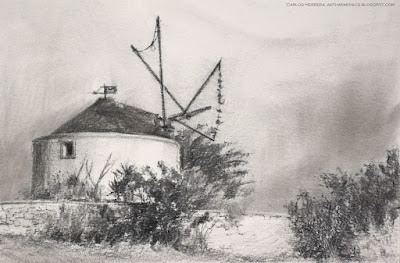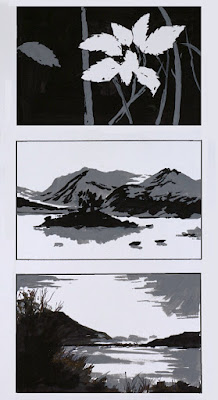 |
| Duck in the Pond |
Exploring Traditional and Digital Painting Techniques. Rebelle Featured Artist.
Sunday, September 27, 2015
Monday, September 14, 2015
Color Sketch
Charcoal Sketch on Gesso-Primed Paper
Thursday, September 10, 2015
Sketching with Abstract Shapes
Sunday, September 6, 2015
Thursday, August 27, 2015
Scranton, Pennsylvania
I have included the notan [with notes] of the painting so you could have an idea of my thinking process in balancing the composition. Squinting helps you see how closely I followed the notan.
Gouache on watercolor paper. Historical painting based on the development of Scranton area, circa 1959.
Gouache on watercolor paper. Historical painting based on the development of Scranton area, circa 1959.
Monday, August 24, 2015
3-Step and 4-Step Notans
Notans are useful for more than just practicing sketching or for getting familiar with the potential subject of a final painting. Notans can be a serious tool for exploration and focusing your creative skill so as to maximize the abstract beauty and pleasantness of the final work of art.
Black and white notans can give you a global idea of a good or weak composition. Notans are an essential step in simplifying the application of the rules of composition to the subject. Being very small, notans make it easy to see where we need to improve the composition within the borders. If the abstract masses seen to interplay together well, being in balance and creating interesting shapes and patterns, then there is a good chance that the final artwork will keep a strong design until finished. To this end, squinting enables the artist evaluate how close the painting is to the notan in its global value range.
The 3-step notan is used for studying the distribution and balance of the forms in the shadow zone. It is up to the artist to modify the shadow values to create different moods in the painting. The simple 3-step notan is appropriate for most dark scenes. Sunset scenes fall in this category.
The 4-step notan quickly lets you see additional elements of the design in the light zone. Good for sunny scenes with lots of contrast that usually have less dark values. Notice how this is true when you are painting the sunny side of buildings in a cityscape
In my private classes I teach step-by-step how to transfer the approved [design] concepts in the notan into the final painting. Once the color harmony has been chosen, the notan helps as a general guide for color mixing and keeping the correct color values within the light and shadow zones of the painting. That will make for a better painting!
Black and white notans can give you a global idea of a good or weak composition. Notans are an essential step in simplifying the application of the rules of composition to the subject. Being very small, notans make it easy to see where we need to improve the composition within the borders. If the abstract masses seen to interplay together well, being in balance and creating interesting shapes and patterns, then there is a good chance that the final artwork will keep a strong design until finished. To this end, squinting enables the artist evaluate how close the painting is to the notan in its global value range.
The 3-step notan is used for studying the distribution and balance of the forms in the shadow zone. It is up to the artist to modify the shadow values to create different moods in the painting. The simple 3-step notan is appropriate for most dark scenes. Sunset scenes fall in this category.
The 4-step notan quickly lets you see additional elements of the design in the light zone. Good for sunny scenes with lots of contrast that usually have less dark values. Notice how this is true when you are painting the sunny side of buildings in a cityscape
In my private classes I teach step-by-step how to transfer the approved [design] concepts in the notan into the final painting. Once the color harmony has been chosen, the notan helps as a general guide for color mixing and keeping the correct color values within the light and shadow zones of the painting. That will make for a better painting!
 |
| 3-Step and 4-step Value Notans |
Saturday, August 22, 2015
Monday, August 17, 2015
Notans and Black and White Sketches
Creating notans and simplified black and white sketches -before committing to a painting- help us determine if the distribution and size of dark and light masses will form a balanced and pleasing configuration. Here is were the format, composition, pathway of the viewer's eyes, and other abstractions of the painting are examined and decided. Once a notan or sketch is approved, we keep it nearby to help us stay within the mass distributions; preventing us from getting too distracted with drawing details and color.
 |
| Simple, but Crucial |
Subscribe to:
Posts (Atom)















